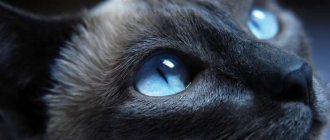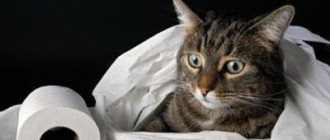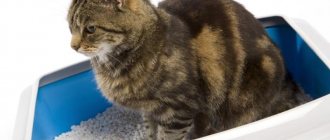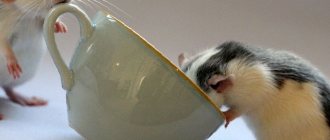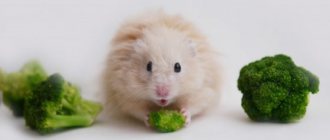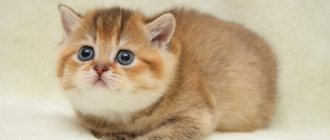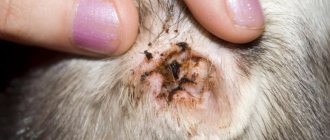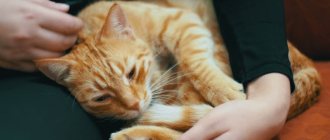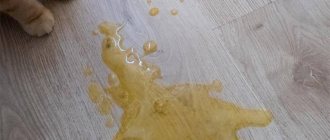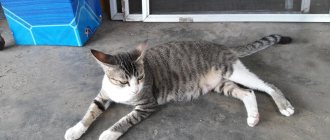Causes of vomiting and diarrhea at the same time
Diarrhea and vomiting in a cat, observed simultaneously, can have completely different causes. This can be either banal overeating, which can be successfully treated at home, or a serious infectious disease or the consequences of an injury, in which case the help of a specialist cannot be avoided.
Vomiting and diarrhea in a cat
Therefore, it is important to diagnose the cause of the illness in a timely manner and provide the necessary assistance to the animal yourself or by contacting a veterinary clinic.
Pathologies accompanied by vomiting and diarrhea
If vomiting and diarrhea continue for more than a day, are accompanied by fever and deterioration in general condition, and the animal refuses food and water, then this is a reason to sound the alarm, because the reasons can be very serious:
- allergic reaction to food;
- pathologies in the gastrointestinal tract, inflammation of the mucous membrane, tumors;
- kidney disease, liver disease;
- consequence of taking or overdose of medications;
- sun or heatstroke;
- otitis.
For your information! Vomiting can also be observed in an animal after a fall from a height, injury, or a blow to the abdominal area. In this case, you should immediately contact the clinic, since the pet may have internal bleeding and ruptures of the abdominal organs, which only a doctor can diagnose.
The presence of blood in the vomit and feces indicates the presence of parasites in the cat’s body, which should also be treated by a doctor after a full examination and tests.
Non-pathological causes of nausea and diarrhea at the same time
Nausea and diarrhea that last less than a day, while the cat does not refuse food and continues to lead an active lifestyle, do not cause concern. These symptoms are not the cause of the disease, and the reasons for their occurrence may be the following:
- overeating due to rapid ingestion of food;
- a sharp change in the animal’s diet;
- hairballs accumulated in the stomach;
- poor quality or expired food.
In addition, vomiting and diarrhea can be a consequence of the cat’s poor diet and neglectful attitude of the owners.
Possible causes of discomfort
You cannot feed a cat the same food that people eat and allow it to rummage through garbage bags.
Important! To prevent your pet from having problems with stool and stomach, the cat should eat only fresh, high-quality food.
Infectious diseases
Domestic cats are susceptible to the following diseases, accompanied by prolonged intestinal upset and vomiting:
- panleukopenia;
- campylobacteriosis;
- viral leukemia in cats;
- coronavirus peritonitis;
- rotavirus enteritis.
The main source of infection is contaminated food, as well as animal dishes, contact with a sick animal or rodent carrier. Older cats and individuals under two years of age are more often at risk.
Poisoning of various etiologies
In case of poisoning, the body's normal reactions are vomiting and diarrhea in order to get rid of toxins as quickly as possible. There is a distinction between food poisoning, when toxic substances enter the cat's body with food, and non-food poisoning, when the toxins are inhaled by the animal or enter through the skin.
Note! A cat can become poisoned by garden chemicals, chewing grass in the garden, or poisonous gases (combustion products, acid vapors or mercury).
Causes for small kittens
The digestive system of small kittens is still developing, so they may vomit and vomit even if they eat high-quality food. Often the cause of illness is:
- stress when a kitten is abruptly separated from its mother and brought to a new home;
- sudden change in diet and feeding regimen;
- too fatty and rich food (overeating).
In addition, kittens are more susceptible to infections and bacteria than adult cats, since their immunity is not yet strong.
Important! It is not recommended to feed a kitten from the same bowl as an adult animal, as the risk of the baby contracting a viral infection from the carrier cat increases.
Treatment and first aid
With severe nausea and diarrhea, dehydration occurs. The cat becomes weak and cannot always reach the bowl. Therefore, the second one is placed next to the bed. It is recommended to pour only boiled or bottled liquid.
If the cat does not drink, they force him to drink - after each bowel movement or attack. Water is poured into the mouth from a syringe (without a needle). Feeding stops immediately. This reduces the load on the gastrointestinal tract. Symptoms may be caused by intoxication of the body. Smecta, Enterosgel, and activated carbon help improve the condition . These drugs can be given before consulting a doctor.
The first two medications are fed ½ sachet immediately after vomiting, after each bowel movement. If the animal refuses to lick the gel, it is diluted with a small amount of liquid. If coal is given, 2-3 tablets are crushed to a powder. Dilute in 2 tbsp. l. water, pour in with a syringe.
Treatment depends on the cause of the vomiting and diarrhea. If it is physiological (stress, rapid swallowing of food, foreign body entering the stomach), then the attacks will go away on their own. In some cases, more serious measures may be needed. If your cat has diarrhea and vomiting, how to treat it depends on the following:
- worms - give anthelmintic drugs;
- infection through dirty dishes, raw food - the pet’s bowl is thoroughly washed;
- diseases – eliminate the original pathology;
- disruption of the gastrointestinal tract - give crushed “Pancreatin” ;
- a consequence of taking antibiotics - Hilak Forte .
It is important to provide the animal with rest. Eliminate irritating factors (attention from other pets, noise), stress. It’s hard for the cat at this time, she becomes irritable. Therefore, it is important to be patient, talk, act carefully, affectionately. She will feel supported and will tolerate treatment more easily.
The cat vomits after eating what to do
Why does a cat snore and what to do?
Why does a cat vomit
What to give a kitten for vomiting and diarrhea as first aid
Small kittens have fragile bodies. Adult medications are not recommended for them. The exceptions are “Phosphalugel”, “Enterosgel”, “Smecta”, “Hilak Forte” . After each attack, the kitten is given 1 tsp. gel.
If he refuses to lick it, the product is diluted with water, then infused forcibly. At the same time, the kitten is put on a starvation diet for 12 hours. Make sure a bowl of water is available. However, this does not cancel an urgent trip to a specialist.
First aid for adult cats
When nausea or diarrhea occurs, sorbents are given - Smecta, Phosphalugel . If they do not help, a doctor's examination is required. At the same time, they are put on a starvation diet for at least a day. If the cat does not drink on its own, they do it by force. However, the risk of another attack increases.
If it is not possible to see a doctor immediately, Ringer-Locke . Usually IVs are given. But without experience it is difficult and dangerous to do this, then you can administer the drug subcutaneously. For an average-sized animal, 150 ml per day is required. However, in any case, the cat must be taken to the veterinary clinic.
Duration of symptoms
Diarrhea in a cat: how to treat it at home
Minor gastrointestinal disorders that are not accompanied by fever, loss of appetite, general lethargy or excessive anxiety are not a reason to panic. This is most likely an adaptation to new food, place of residence, or normal overeating. In most cases, symptoms disappear without a trace within 24 hours.
If the cat is sick for more than 48 hours, refuses food and water and literally does not leave the tray, you should contact a veterinarian, as this is fraught with dehydration and liver dystrophy.
Duration of symptoms - loose stools and nausea
Only a complete diagnostic examination and tests will help determine the cause of the ailment.
Definition of pathologies
First, let’s define the terms, as well as what diarrhea and vomiting in a one-month-old kitten can be like.
Diarrhea
In kittens, feces are often mushy, light shades of brown; they have this appearance as long as the animals are fed with mother's milk. When switching to an adult diet, the feces become dark brown. The normal frequency of bowel movements is 1-2 times a day ; in small kittens it can be up to 3 times.
Diarrhea or diarrhea is a situation where a pet relieves itself frequently, but the stool is usually liquid. This situation should not be confused with the case when the animal often sits in a defecation position, but there is no feces. This is already constipation. Important diagnostic signs are the color and time of diarrhea after eating, as well as the presence of foreign impurities.
Vomit
A reflex act in which the contents of the stomach are ejected through the mouth (and sometimes through the nose too). Vomiting occurs when the vomiting center in the central nervous system is stimulated; such stimulation is possible due to toxins or direct irritation of the brain. Usually indicates acute diseases in the stomach or intestines, usually of an inflammatory nature.
Vomiting is often preceded by nausea - a condition when there is excitement in the vomiting center, but it is not enough for the act of vomiting. Gagging is often confused with coughing. They can be distinguished by the movements of the chest and abdomen. The chest is involved in coughing; the act itself is quick and harsh. The abdominal wall is involved in vomiting, the animal’s back often bends in an arc, and the act is longer.
How to determine the cause of illness
Only a doctor can determine the cause of an animal’s illness, based on the results of tests and examination. However, in some cases, when it is not possible to get to the veterinarian, the owner must be able to distinguish a viral infection from overeating and give the pet medicine in a timely manner.
Diarrhea in a kitten: what to do and how to treat it at home
Cats periodically regurgitate fur accumulated in the stomach, so this phenomenon is considered normal. If bloody clots are observed in the vomit, this indicates irritation of the gastric mucosa or the presence of a tumor.
If the stool is yellow, this indicates serious problems with the liver; green color indicates rotting processes in the intestines due to eating spoiled foods; white - about problems with the gallbladder or blockage of the bile ducts. Abundant mucus in the stool indicates infection of the body with parasites.
If a cat vomits white foam
If a domestic cat suddenly vomits white foam, and he has not previously shown concern or had problems with bowel movements, then the pet is simply hungry. The animal’s body produces enzymes and gastric juice, which irritate the gastric mucosa, which is why vomiting occurs.
How to treat vomiting in a cat
For your information! The cat's body synthesizes enzymes and gastric secretions in normal quantities even after fasting for several days.
Usually, vomiting white foam is not a symptom of any serious pathology; simply feeding your pet is enough.
Reasons for violation
If the cat returned to normal within 24 hours, the diarrhea and nausea disappeared, then most likely the cause was simple poisoning. No need to worry about this. However, to prevent this from happening in the future, you should :
- exclude low-quality or expired products from your pet’s diet;
- try changing your diet;
- set a clear time for feeding the cat, try to prevent the animal from overeating and swallowing large pieces of food;
- Include vegetable oil in your cat’s diet to improve wool digestion.
If a cat vomits and diarrhea for more than a day, then the reasons for this may be::
- allergic reactions to food or medications;
- damage to the body by infections;
- helminths in internal organs;
- formations in the gastrointestinal tract;
- adverse reactions to medications taken;
- heat or sunstroke;
- liver and kidney diseases;
- reaction to a certain type of food.
The reasons for vomiting blood in a cat lie in the presence of helminths in the animal. They penetrate the internal organs and slowly destroy them. Hence the appearance of blood particles in the vomit.
© shutterstock
Diagnosis of pathologies
Constipation in a cat: what to do at home
To diagnose diseases accompanied by vomiting and diarrhea, the following methods are used in veterinary practice:
- biochemical examination of feces and vomit, testing for the presence of reovirus infection;
- ultrasound examination of the abdominal cavity, x-ray;
- general blood analysis;
- taking a swab from the mouth and rectum;
- study of markers for the presence of pancreatic insufficiency or pancreatitis;
- culture for salmonellosis is carried out.
Diagnosis of the causes of ailments
These measures will help determine the cause of the ailment and determine whether the symptoms are gastrointestinal or extraintestinal diseases. In addition, the doctor evaluates the animal’s appearance and its reaction to stimuli.
When there is no reason to worry
If unpleasant symptoms in the form of vomiting and loose stools bother the animal for a short time, appear no more than 2-3 times a day and go away every other day, then the owner has nothing to worry about.
In such situations, it is enough to provide first aid. Changing the animal's diet will help achieve a positive result.
It is worth noting that diarrhea and vomiting are often observed in cats after giving birth. This is how the body responds to stress.
Unpleasant symptoms disappear within a maximum of 24-48 hours.
First aid for a pet at home
You can help your pet at home only if the owner is 100% sure that vomiting and diarrhea are a consequence of overeating or switching to a new food. This reaction is normal for the animal's body. In other cases, it is better not to risk it and take the animal to a veterinary clinic as soon as possible.
First aid
What to do if a cat is diarrhea and vomiting and how to provide first aid at home:
- to stop diarrhea and avoid dehydration, you need to give the animal an astringent for cats based on oak bark;
- To eliminate vomiting, as well as restore the intestinal microflora, it is worth purchasing probiotics from a veterinary pharmacy (you can give the human drug Hilak Forte, cats like its taste). This will also relieve the animal from diarrhea;
- Activated carbon works well, working as an adsorbent. An adult cat will only need half a tablet, which should be crushed, mixed with warm water and poured into the mouth with a syringe;
- after a repeated case of vomiting or diarrhea, you need to limit the cat’s food for 8-12 hours. If after this time the animal begins to refuse the offered food, you should urgently seek specialized help, since prolonged fasting (more than 48 hours) causes irreversible changes in the work liver;
- On the contrary, the animal must have plenty of water. It is important to change it frequently, that is, after each time the cat drinks, you need to throw out the water from the bowl and replace it with clean water.
If the symptoms do not go away on the second day and the animal begins to feel worse, you should immediately consult a doctor. If the condition has improved, it will be useful to give the cat pumpkin puree 2-3 times a day for 4-6 days.
Prevention
To avoid nausea and diarrhea in your cat, follow these rules.
- Give your pet only fresh, high-quality food. With natural nutrition, the diet is correctly composed. Bowls for food and water are washed regularly and food is not allowed to remain in them.
- Vaccinations against infectious diseases are given in a timely manner. Deworming is carried out 2–4 times a year.
- All medications are given to a cat only after consultation with a veterinarian. Strictly follow the instructions for use of the drugs.
- Limit the pet’s access to garbage dumps, deratization facilities, and dog walking areas.
Medications
After the examination, the doctor prescribes a comprehensive treatment based on the test results. Drugs are used depending on the identified disease:
- antiviral or antimicrobial;
- antibiotics;
- enzymes;
- adsorbents and probiotics;
- immunostimulants.
Drug treatment
Note! Also, to eliminate the consequences of intoxication of the body, the animal is prescribed IVs, enemas or gastric lavage.
Treatment of the underlying disease
The main specific treatment can be started only after an accurate diagnosis has been established, and what to do, which drug to choose and dosage, must be decided by the veterinarian. Possible treatment regimens are as follows:
- For bacterial infections, antimicrobial drugs of gastrointestinal and systemic action are prescribed. Since pathogenic microflora kills the natural one, probiotics containing beneficial microorganisms are prescribed.
- When infected with intestinal parasites, anthelmintics are prescribed. You will have to drink them 1-2 times, due to the fact that parasites often have a complex development cycle. The drug is selected based on the type of parasite.
- For inflammatory processes (gastroenteritis, pancreatitis and others), systemic non-steroidal anti-inflammatory drugs are prescribed. At the same time, enzymatic preparations are prescribed to facilitate the functioning of the liver and pancreas.
- When there is a blockage in the intestines, surgery is performed first. After this, the veterinarian prescribes antibiotics to eliminate the risk of infection, as well as enzyme preparations, and later prescribes probiotics to restore the microflora.
- In case of hormonal imbalance , hormonal medications are necessarily prescribed, and you will most likely have to take them for the rest of your life. But a complete recovery is also possible, provided that the cause of the hormonal imbalance can be eliminated.
What not to do if your cat has nausea and diarrhea
If a cat vomits and diarrhea for more than a day, under no circumstances should you self-medicate or give the animal medications without conducting an examination. In addition, it is dangerous to give an animal human medications because the body's reaction can be unpredictable.
Only a veterinarian, having found out the cause of the ailment, can prescribe treatment. After all, vomiting and diarrhea can be caused by both a bacterial infection and a viral one. Incorrect treatment can be fatal.
Important! After the first symptoms of illness, you should not give your cat fermented milk products, raw meat or dry food. It will be useful to have a fasting day.
Prevention of diarrhea and vomiting in cats
The following recommendations should be followed as preventive measures:
do not allow your pet to come into contact with homeless animals;- regularly perform hygiene procedures;
- Wash water and food bowls after each use;
- choose quality feed;
- do not feed human food;
- Have your pet examined by a veterinarian periodically.
To prevent the appearance of worms, deworming should be carried out at least once every 3 months.
When is surgery needed?
Surgery, if the cat has diarrhea and vomiting that does not stop even after taking medications, may be needed in the following cases:
- a foreign object was found in the animal’s gastrointestinal tract;
- diseases of the stomach or intestines, such as ulcers or erosion, have been identified;
- oncological diseases of the abdominal organs.
Surgery
In other cases, surgical intervention can be avoided if the disease is diagnosed in time and treatment is prescribed correctly.
How to treat?
Treatment of diarrhea and vomiting in cats is carried out comprehensively. Therapy includes medications, diet, and special care.
Medicines are prescribed by the doctor after studying the test results and determining the diagnosis:
- for infections, antibiotics are prescribed;
- helminthic lesions are treated with anthelmintics;
- allergic reactions require the use of antihistamines;
- inflammation is controlled with corticosteroids;
- vitamin complexes support the immune system.
In addition, it is necessary to restore the intestinal microflora and remove toxins. Many medications used to treat humans are suitable for restoring intestinal microflora in cats:
- Lactofiltrum will help remove toxins from the body;
- restore the natural intestinal microflora, reduce acidity, reduce inflammation of the mucous membrane - Phosphalugel does an excellent job of this;
- probiotic Hilak Forte stabilizes the microflora and relieves the consequences of antibiotic use; cats like its taste, they themselves happily lick it off their fingers.
Dosages and dosage regimens are prescribed by the doctor; self-medication is dangerous for the pet’s health.
Phosphalugel
For the first few days, the animal is advised to fast; its duration depends on the severity of the condition. Next, you should switch to special food for a while. Its balanced composition provides the body with all the necessary elements, while maintaining the normal functioning of the gastrointestinal tract. At first, food should be given in small portions so as not to overload the stomach.
What to feed a sick cat with diarrhea and vomiting
To alleviate your pet’s condition, you need to adhere to a certain diet:
- ensure unimpeded access to clean drinking water;
- fast for 24 hours for an adult animal or 12 hours for a kitten;
- exclude all foods from the human diet. It is optimal to give medicinal cat food for sensitive digestion or hystrointensive.
What to feed a cat
Note! You can try feeding a cat suffering from diarrhea rice water; it has an astringent effect and reduces the frequency of trips to the litter box.
What can cause vomiting and diarrhea in cats?
The owner's observations of the pet's behavior can provide significant assistance in making a diagnosis. In any case, you need to know all the factors underlying the root cause of this condition in your pet:
- Worm infestation;
- Poisoning from medications, stale or expired food or chemicals;
- Sudden change in diet;
- Allergic reaction;
- Pathology of the liver, kidneys or pancreas;
- Entering the body with a viral or bacterial infection;
- Development of benign or malignant neoplasms.
It is especially worth paying attention when the cat is sick and has diarrhea mixed with blood. You cannot do this without qualified help from a veterinarian, and therefore you should not put off visiting the doctor.
How to help your cat if you can’t call a veterinarian
To stop attacks of diarrhea and vomiting, do not feed your pet. Therapeutic fasting on the first day will help reduce the symptoms of diarrhea.
Be sure to wash your pet's dishes, as pathogens may be present in them.
The microflora of an animal can be restored using Bificol or Probifor.
The cat must have constant access to clean water.
Take your pet to the veterinarian as soon as possible. You should not give antibacterial drugs to a sick cat on your own, without consulting a specialist.
